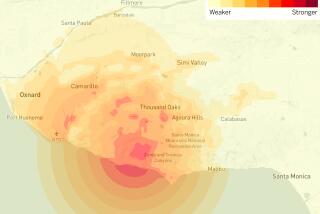Bay Area earthquake rattled 9.8 million people — and offers a preview of something much worse
It was a sharp jolt but also a warning of something much more violent that could be coming.
An estimated 9.8 million people felt a magnitude 4.4 earthquake that rumbled across the Bay Area early Thursday, the U.S. Geological Survey reported.
It was felt throughout the region, with people more than 150 miles away reporting to the agency that they felt the shaking for perhaps five to 10 seconds.
The epicenter of the earthquake is in the area of the Hayward fault, one of the most feared in the Bay Area, which could produce a magnitude 7 or greater earthquake and is directly underneath heavily populated areas.
The Hayward fault, along with the San Andreas fault on the San Francisco Peninsula, have long posed a twin seismic peril to the region. The San Andreas produced the devastating 1989 Loma Prieta quake and 1906 San Francisco quake.
Thursday’s quake was tiny by comparison and did little damage to speak of.
The shaking was strong enough to wake people up when the earthquake hit at 2:39 a.m. One person in San Francisco said it was strong enough to knock picture frames from the wall.
As is always the case, there was a 5% chance the temblor could trigger a larger quake in the near future.
“We live in earthquake country, so we should all expect earthquakes,” said Keith Knudsen, deputy director of the USGS Earthquake Science Center. “There will likely be aftershocks. There’s a small probability there will be bigger ones.”
An earthquake early warning system under development worked — and sent data about the temblor to computers 4 seconds after it began, Knudsen said.
In a real-world scenario, the jolt felt Thursday would probably not be considered big enough to issue a warning to residents in the path of the shaking, he said.
“But having one up and running and testing it is really valuable to us. How much warning time one gets depends on how far away they are, how big it is, how dense the seismic network is and how rapidly the computers are processing,” he said.
The system would typically allow a few seconds of warning for people not close to the epicenter — which would be enough time in theory to slow trains, stop elevators and allow people to brace themselves.
When asked Thursday at a news conference whether Californians were ready for an earthquake, Knudsen demurred.
“I’d ask you, are you prepared?” he said. “We’re doing better than we used to do. But there’s more that can be done.”
The earthquake was felt as far away as Marin and Sonoma counties and the Silicon Valley. Some Bay Area residents reported that the earthquake woke them up.
“Only M4.5, the size we have several times a year in California,” tweeted seismologist Lucy Jones. “But when you are right on top of a quake, it feels much stronger.”
The Hayward fault courses right underneath Berkeley, Oakland, Hayward and Fremont and produces a large earthquake, on average, every 160 years, with a margin of error of about 80 years. It has been 150 years since the Hayward fault last ruptured, unleashing a huge earthquake.
The Hayward fault’s most memorable earthquake in recorded history was in 1868, and is estimated to have been a magnitude 6.8 earthquake — rupturing 20 miles of the fault’s length between San Leandro to what is now the Warm Springs neighborhood of Fremont, according to the USGS. It killed about 30 people and caused immense property damage, including the collapse of the Alameda County Courthouse’s second floor and heavy damage at the historic Mission San Jose adobe church in southern Fremont.

The Hayward fault is considered one of the nation’s most dangerous faults because it is located directly under the urban centers of the East Bay, including Memorial Stadium at UC Berkeley and a now-shuttered building that formerly housed Hayward City Hall, which is slowly being torn up by fault movement.
A USGS scenario for a 7.0 earthquake on the Hayward fault envisions it rupturing for 52 miles from San Pablo Bay to Fremont. It would cause one side of the fault to move four feet from the other. Many buildings, including apartments, still sit directly on top of the fault line, and were built before a state law passed in 1972 prohibiting new construction or substantial renovation on top of earthquake faults.
On its website, the USGS calls the Hayward fault the region’s “tectonic time bomb,” which could “cause hundreds of deaths, leave thousands homeless and devastate the region’s economy.”
In 2016, David Schwartz, a USGS geologist, said in an interview that above the Hayward fault are “2 million people who directly live on top of it. It sits geographically in the center of the Bay Area. There’s a tremendous amount of infrastructure built up on it — water systems, gas, electrical, BART crosses it — so a large event on that fault is like hitting the bull’s eye on a target.”
Lin reported from San Francisco, Serna from Los Angeles.
UPDATES:
4 p.m.: This article was reworked at the top with new lede.
7:50 a.m.: Updated with downgraded magnitude to 4.4 and comments from USGS officials.
6:40 a.m.: Updated with no reports of damage or injuries in San Francisco.
3:35 a.m.: Updated with context about the Hayward fault.
3:10 a.m.: Updated with locations where the earthquake was felt.
3:02 a.m.: Updated with quote from a USGS seismologist.
This article was originally published at 2:55 a.m.
More to Read
Start your day right
Sign up for Essential California for news, features and recommendations from the L.A. Times and beyond in your inbox six days a week.
You may occasionally receive promotional content from the Los Angeles Times.








